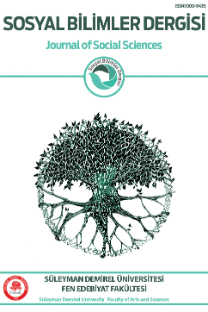Kalıtsal Petrol Monarşileri: Neden Arap Baharı GCC Arap Devletlerinde Başarısız Oldu?
Körfez İşbirliği Ülkeleri, Arap Baharı, Monarşi Rejimleri
Hereditary Oil Monarchies: Why Arab Spring Fails in GCC Arabian States?
Gulf Cooperation Council, Arabic Spring, Monarchy Regimes,
___
- Books ABDEL- RAHMAN YOUSRI,Ahmad, “Islamic Banking Modes of Finance: Proposals for Further Evolution”, Munawar Iqbal and Rodney Wilson (eds.), Islamic Perspectives on Wealth Creation, (Edinburgh University Press, 2005): 32–
- AYUBI, Nazih N. Over-stating the Arab State: Politics and Society in the Middle East. New York: I.B. Tauris, 2008.
- BERNARD Reich, and Mark Gasiorowski, 161-205. Boulder: West view Press, 2011.
- BEVERLY Milton, Edwards. Contemporary Politics in the Middle East. London: Viley, 20 BILL, James A., Robert Springborg. Politics in the Middle East. New York: Harper Collins College Publisher, 1994.
- CRYSTAL, Jill. “Eastern Arabian States: Kuwait, Bahrain, Qatar, UAE, and Oman.”In The Government and Politics of the Middle East and North Africa, ed. David E. Long, FAWCETT, Louise. International Relations of the Middle East. Oxford: Oxford University Press, 2009.
- IQBAL, Mohammad. “Emergence of Saudi Arabia (A Political Study of Malik Abd alAziz ibn Saud 1901–1953)”, Kashmir, (Saudiyah Publishers, 1977):44.
- MAISEL, Sebastian. “Kingdom of Saudi Arabia.” in The Government and Politics of the Middle East and North Africa, ed. David E. Long, Bernard Reich, and Mark Gasiorowski, 161-205. Boulder: Westview Press, 2011. Articles
- AGHSAN, Ali Rahigh, Peter Viggo Jakobsen. “The Rise of Iran: How Durable, How Dangerous?.” The Middle East Journal 64 (2010): 559-573.
- ALHASAN, Hasan Tariq. “The Role of Iran in the Failed Coup of 1981: The IFLB in Bahrain.” Middle East Journal 65 (2011): 603-617.
- GREENFIELD, Beth, The World’s Richest Countries, Forbes, (22 February 2012).
- COOPER, Andrew F., Bessma Momani. “Qatar and Expanded Contours of Small State Diplomacy.” The International Spectator: Italian Journal of International Affairs 46 (2011): 113-128.
- COLOMBO, Silvia. “The GCC and the Arab Spring: A Tale of Double Standards.” The International Spectator: Italian Journal of International Affairs,” 47 (2012): 1101
- DICKEY, Dickey ,”Qatar” , Newsweek,(May 22, 2013).
- EHTESHAMI, Anoushiravan. “Reform from Above: The Politics of Participation in the Oil Monarchies.” International Affairs 79 (2003): 53-75.
- ENTOUS, Adam, “Saudi Arms Deal Advances”, The Wall Street Journal,(12 September 2010).
- FRIEDMAN, Brandon. “Battle For Bahrain: What One Uprising Meant for the Gulf States and Iran.” World Affairs March/April (2012): 74-85.
- KATZMAN, Kenneth, “Oman: Reform, Security, and U. S. Policy” Congressional Reseach Service, April (2011):8.
- MANSFIELD, Edward D., Jack Synder. “Democratization and the Arab Spring.” International Interactions: Empirical and Theoretical Research in International Relations 38 (2012): 722-733.
- MATTHIESEN, Toby. “A Saudi Spring?: The Shi`a Protest Movement in the Eastern Province 2011-2012.” Middle East Journal 66 (2012): 628-659.
- PETERSON, John E. “Succession in the States of the Gulf Cooperation Council.” The Washington Quarterly 24 (2001): 173-186.
- ROBERT, Dennis C. “The Student Personnel Point of View as a Catalyst for Dialogue: 75 Years and Beyond.” Journal of College Student Development 53 (2012): 2ROBINSON, Mary, “Jobs in Oman”, Expat Finder, (Jun 11, 2012).
- ROGERS Simon, and Ami Sedghi, "How Fitch, Moody's and S&P Rate Each Country's Credit Rating". The Guardian, (15 April 2011).
- SPRINGBORG, Robert. “Whither the Arab Spring? 1989 or 1848?.” The International Spectator: Italian Journal of International Affairs 46 (2011): 5-12.
- TETREAULT, Mary Ann. “The Winter of the Arab Spring in the Gulf Monarchies.” Globalizations 8 (2011): 629-637.
- U.S, Department of State Diplomacy in Action, U.S. Relations With Saudi Arabia, Bureau of Near Eastern Affairs, Fact Sheet, (August 23, 2013).
- WHITAKER Brian, “Oman's Sultan Qaboos: a classy despot”, The Guardian, (4 March 2011).
- WIARDA, Howard J. “Arab Fall or Arab Winter?” American Foreign Policy Interests 34 (2012): 134-137.
- YOM, Sean L., F. Gregory Gause III. “Resilient Royals: How Arab Monarchies Hang On.” Journal of Democracy 23 (2012): 74-88.
- The Cooperation for the Arab States of the Gulf (GCC) Secretariat General, “ The Economic Agreement between the GCC States” 22 nd Session, (Muscat: 2001).
- For the Record, “Implications of the Arab Spring,” American Foreign Policy Interests 33 (2011): 293-294.
- ISSN: 1300-9435
- Yayın Aralığı: 3
- Başlangıç: 1995
- Yayıncı: Süleyman Demirel Üniversitesi, Fen-Edebiyat Fakültesi
Ortaçağda Bir Türkiye Selçuklu Kenti Uluborlu
Ermeni Açılımı ve Türk Dünyası
The reflection of direct and indirect politics in pinter’s the birthday party and one for the road
Dindarlık Tipolojileri İle Benlik Saygısı Arasındaki İlişki: Yetişkinler Üzerine Bir Araştırma
FUAT GÜLLÜPINAR, Abdullah KUZU, ÖZCAN ÖZGÜR DURSUN, Adile Aşkım KURT, MEHMET GÜLTEKİN
Buket uzuner’in “önceki ve sonraki kadın” hikâyesine feminist bir bakış
Zübeyde BİLDİRİCİ, Ramazan GÜLENDAM
Temettuat defterine göre seydişehir’in sosyoekonomik yapısı
Geleneksel? Modern? Veya Her İkisi? Türk Televizyon Reklamlarında Toplumsal Cinsiyet Temsili
